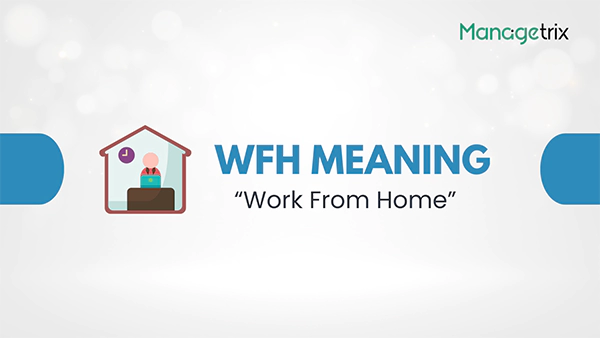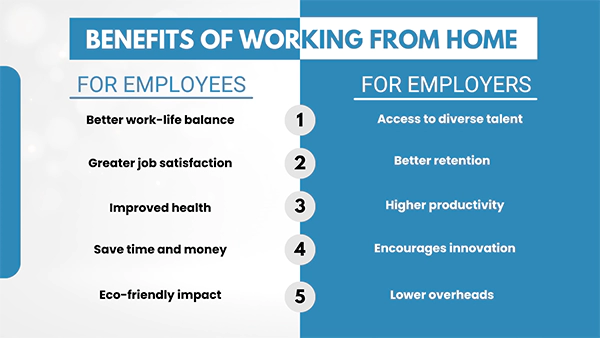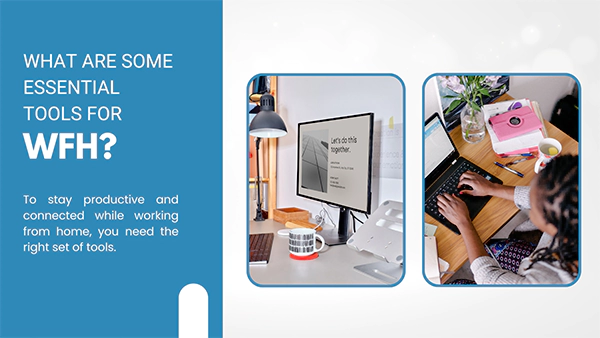In 2025, 16% of organizations globally operate remotely, and about 63% work on a hybrid model. The trend that started during the COVID-19 pandemic has changed modern workplace dynamics. WFH, either completely or hybrid, has become the new norm.
But what does WFH mean? WFH or Work From Home allows employees to work remotely from any place they prefer. Modern technology and evolving culture have made WFH an integral part of the working environment.
In this quick guide, I will explain the WFH meaning, key benefits, challenges, tips to stay productive, and how to manage WFH effectively.
What is WFH Meaning?
WFH meaning is Work From Home, and it simply means doing your job from your house instead of going to the office. Whether it is a full-time setup or just a few days a week, many companies now allow employees to work remotely.

People who work from home stay connected with teammates through video calls, chat apps, and other online tools. This allows the work to keep moving even if everyone is in a different place.
You may also come across terms like WFA (Work From Anywhere) and WFO (Work From Office). These flexible ways of working are now common in many industries, thanks to better technology and changing work habits.
Also Read: What is the VTO Meaning? (Voluntary Time Off)?
What is the Difference Between WFH and Remote Work?
Though work from home and remote work often sound like the same thing, there is a clear difference. Both involve working outside the office, but how and where you work make all the difference.
Here’s a clear breakdown of WFH meaning and the concept of remote work:
| Basis | Remote Work | Work From Home |
| Meaning | You can work from anywhere, not just at home. | Full or part-time work from home instead of going to the office. |
| Scope | Covers any non-office setup, giving more location freedom. | It usually means staying home during work hours. |
| Type of Worker | Can include freelancers, contractors, digital nomads, and employees. | Usually full-time employees. |
| Supervision | Encourages autonomy with a focus on output over hours. | May still include regular check-ins and fixed work hours. |
| Flexibility | Offers full flexibility in terms of time and locations. | May include occasional office visits. |
| Team Work | It relies on asynchronous communication and coordination across time zones. | Uses tools like Zoom or Slack for daily communication. |
In short, WFH is a type of remote work, but remote work goes beyond just staying home. It is a broader concept with location freedom, flexible schedules, and diverse work setups.
Also Read: Difference Between HRM and HRD: Holistic Comparison and Analysis
What are the Benefits of Working From Home?

Working from home is not just a trend; it is reshaping how we view work. Now that you know what is WFH, let’s explore what makes it great for both individuals and organizations.
For Employees
- Better work-life balance: Working from home gives flexibility to manage work and personal life in harmony.
- Greater job satisfaction: No commuting and working from a comfortable environment boosts happiness.
- Improved health: It often means more time for self-care, leading to better mental and physical well-being.
- Save time and money: Skipping the daily commute lowers your cost and gives you more time.
- Eco-friendly impact: With less commuting, remote work from home can also reduce pollution and traffic congestion.
For Employers
- Access to diverse talent: Remote teams are not limited by geography. Thus, you can hire skilled people from anywhere.
- Better retention: Offering full- or part-time work from home options reflects trust and improves employee loyalty.
- Higher productivity: With fewer in-office interruptions, employees may perform more efficiently.
- Encourages innovation: New perspectives and flexible setups often lead to new and creative ideas.
- Lower overheads: Companies can cut down on costs related to office space, supplies, and utilities. This gives them the option to invest those savings elsewhere.
Whether it is a storm or a pandemic, having a great work-from-home arrangement helps keep things running smoothly when physical offices are not available.
Common Challenges of Remote Work From Home
While working from home brings flexibility, it also comes with a unique set of challenges for both employers and employees.
For Employees
- Feeling of isolation: Working alone for long hours can lead to loneliness and affect mental well-being.
- Home distractions: Noise, household duties, and family interruptions can break your focus.
- Work-life management: It is easy to overwork when there is no clear divide between office and home, which can lead to fatigue.
- Lack of routine: Without structure, staying motivated and on-task can be a challenge.
For Employers
- Effectively managing teams: Without face-to-face interaction, tracking progress and providing real-time support can be tough.
- Building team spirit takes effort: Employers need to find a new way to promote connection, collaboration, and company culture.
- Tricky onboarding: Welcoming and training a new employee remotely can feel less personal and effective. It can also add to the roles and responsibilities of the HR team.
- Cybersecurity concerns: Remote work from home setups often rely on personal networks, increasing the risk of data breaches.
These are some of the major concerns in front of companies and individuals. However, one can easily overcome them by incorporating some simple habits.
How to Manage Work From Home Effectively?
Working from home can be productive and enjoyable if you approach it the right way. Here’s how to make it work smoothly for both employees and employers:
- Keep Communication Clear and Consistent
Use tools like Zoom, Slack, or Teams to stay in touch regularly with your team and HR manager. Quick check-ins and open chats can help everyone stay on the same page and avoid confusion.
- Create a Suitable Routine
Start by figuring out when you are naturally most productive. Use those high-energy hours for deep work and schedule lighter tasks when your energy dips. You need to build a routine that supports your lifestyle, not fights against it.
- Set Clear Work Hours
Define your work timings and communicate them clearly to your team. This keeps the work structure and reduces last-minute stress.
- Build a Distraction-Free Workspace
A great work-from-home setup requires a quiet corner at home. A well-lit and clutter-free space not only improves focus but also signals your brain about work time.
- Use the Right Tools to Stay Ahead
Technology can make or break your remote work from home experience. Use apps and tools to cancel background noise, take automatic meeting notes, and stay present in every call. Apps like Google Calendar and Notion can help you organize your day and tasks.
- Manage Distractions
Put your phone on Do Not Disturb and use website blockers to manage distractions. Also, it is important to communicate with others at home about your work hours.
- Take Regular Breaks
It is recommended to stay away from the screen for some time every few hours. Stretch, grab a coffee, or just take a short walk. These breaks refresh your mind and help you stay productive throughout the day.
- Prioritize Your Physical and Mental Health
Nothing is more important than a healthy body. Eat well, stay hydrated, and add some movement to your day. Even a 10-minute walk or quick meditation can help your mood and focus.
- Work-Life Balance
Log off on time and avoid checking emails after your working hours. It is crucial to take proper time off when you need it. A healthy boundary between work and life leads to better performance and overall happiness.
- Promote Virtual Team Bonding
All work and no play is never a sustainable approach. Don’t skip the fun part. Plan virtual coffee breaks or casual team catchups. Social interaction keeps morale high and makes remote work less isolating.
- Share and Receive Feedback
Appreciate team wins, share what’s working for you, and talk about what is not working. Regular recognition and support go a long way in a remote setup.
By following these tips, WFH becomes more organized, healthy, and enjoyable for both individuals and companies.
Also Read: Bimonthly vs Biweekly Payroll – What You Need to Know in 2025
What are Some Essential Tools for WFH?

To stay productive and connected while working from home, you need the right set of tools. It is the responsibility of both employees and employers to make sure everyone can communicate and manage work efficiently.
- Communication and collaboration tools like Slack and Microsoft Teams allow teams to chat, make calls, share files, and stay in sync.
- Use project management software to assign tasks, set deadlines, and track progress. This reduces the need for constant emails and ensures everyone is on the same page.
- Cloud storage tools like Google Drive, Dropbox, and iCloud allow teams to access and update documents from anywhere. Choose the ones that are secure and easy to use.
- Screen sharing and recording tools make it easy to share your screen or record tutorials. These are helpful for team discussions and troubleshooting.
- Instead of juggling multiple apps, an all-in-one digital workplace like Notion can help teams collaborate, manage projects, and communicate in one place.
Furthemore, VPNs are also a good tool to protect sensitive company data by encrypting your internet traffic. They are essential for secure remote access.
Final Thoughts
Coming to the end of this guide, I hope that you are now aware of the WFH meaning and its basics. Working from home is shaping the future of how we work. While it offers flexibility and freedom, it also demands focus, routine, and strong boundaries between work and personal life.
As more and more companies allow remote and hybrid models, experts believe that by 2023, nearly one in three workers globally will work from home.
I hope by following the strategies in this guide, you can make remote work both productive and sustainable. If you found this useful, please share this guide with your employees and employers.
Read Next: What Is No Due Certificate Format? How to Write & Download a Sample
Frequently Asked Questions (FAQs)
1. What does WFH stand for?
Ans: The full form of WFH is Work From Home, and it allows employees to work from their homes.
2. What is the meaning of working from home?
Ans: It is a modern arrangement where an employee can work from their home or some other place. They do not have to physically report every day to the office.
3. What is a WFO job?
Ans: WFO stands for Work From Office. It simply means that you are required to physically work from the office space of the company.
4. What is better, WFH or WFO?
Ans: This depends on your preferences and work styles. WFH is for those who can work from home and manage distractions. WFO is suitable for those who require a dedicated workspace and face-to-face interactions.
5. What are some good part-time work-from-home jobs?
Ans: Customer service representative, online teaching, data entry, and social media manager are some of the best part-time jobs you can do from your home.